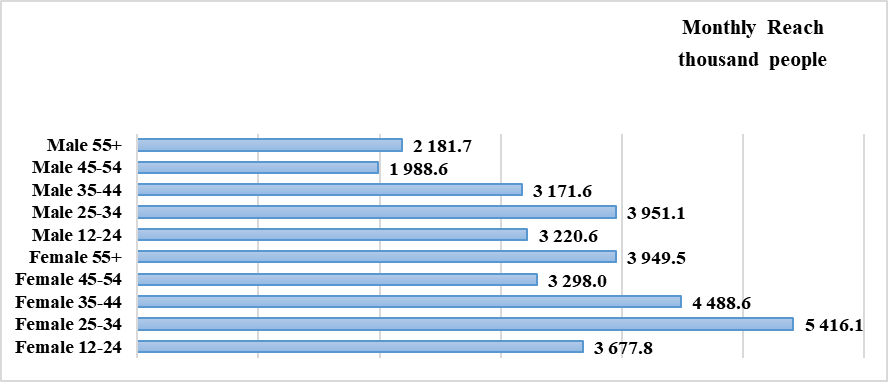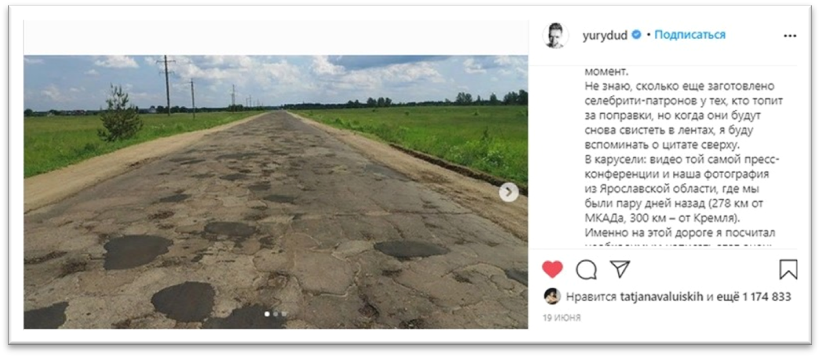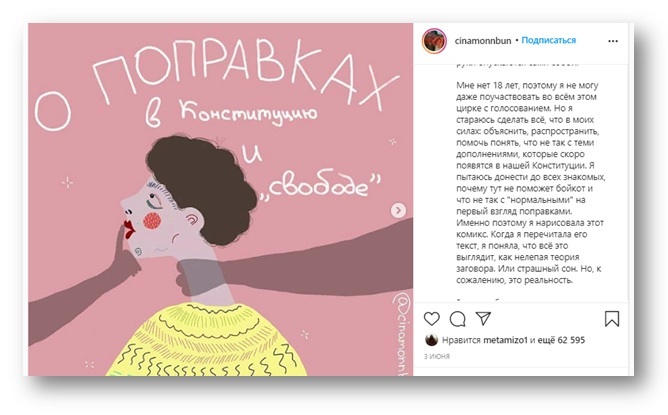Abstract
The article is devoted to the study of the role of social networks, Instagram in particular, in the development of civic engagement and digital democracy. The active spread of civic Internet activism is evidenced by the growth in the number of volunteer movements, “one demand” actions, environmental actions and protest actions, which are also carried out in social networks. In the context of the coronavirus pandemic, youth engagement in online civic events is of particular importance. Questions about whether the digital civic activity of young people in social networks reflects the actual socio-political moods, whether it is able to directly or indirectly influence the socio-economic, social and political processes in the country, are of research interest from a pedagogical point of view, as they affect goal setting, content and forms of civic education and upbringing. The empirical material of the study is the hashtags and texts of posts on Instagram, reflecting the attitudes of Russians regarding voting on the issue of approving amendments to the Constitution of the Russian Federation. The analysis of digital traces is aimed at identifying sources of information popular with Russian youth, as well as the degree of influence of social networks on the social activity of young people in civil society. The results of the study can be used to develop the conceptual foundations of civic education for students and schoolchildren in the context of information diversity.
Keywords: Civic education, civic upbringing, civic Internet activism, Instagram
Introduction
Over the past decade, the importance of social networks in solving global issues of the life of modern society has sharply increased. The total involvement of the younger generation in active digital communication gives rise to the study of a new social phenomenon – digital democracy. An ideal “digital democracy” may turn out to be impractical, and collective decisions, which are of decisive importance for a given political phenomenon, are impossible from the point of view of their implementation. Online actions are often characterized by ephemerality, nihilism and excessive emotionality; they do not reflect the deep essence of the agenda, the understanding of which is necessary for formal effective decision-making. There are also serious threats from the point of view of ensuring information security and information sovereignty of the individual, society, state; distortion of the key principles of political culture in the true sense of this concept; replacing real civic political participation with virtual one.
According to civil society researchers, the main strength of active users of social networks lies in their awareness and informedness of the real state of social problems through the influence of opinion leaders. Almond and Verba (1992) note that living in a civic culture, an ordinary person, more than in any other situation, is inclined to maintain political ties at a high and constant level, to be part of some organization and to participate in informal political discussions. “These activities do not in themselves indicate active participation in public decision-making, but they make such participation more likely. They prepare the individual for intrusion into the political environment in which the inclusion and participation of the citizen becomes more feasible” (Almond, & Verba, 1992, p. 124). Civil Internet activism is emerging as a new form of social and political participation in the life of the country.
Problem Statement
The attention of Russian researchers is directed to the study of Internet activism and its impact on socio-political processes in Russia, the readiness of Russian youth to implement civic and political online activity, destructive civic engagement (Basheva, 2020; Brodovskaya, 2019; Bronnikov, 2019; Dombrovskaya, 2020; Pyrma, 2020; Ryabchenko & Gnedash, 2018; Trofimova, 2015 etc.). The theoretical foundations of the study of civic Internet activism and digital citizenship have been actively developed abroad (Kersting, 2019; Schmidt & Cohen, 2013; Vitak et al., 2011; Vromen, 2017; Xenos et al., 2014).
The authors of a number of studies assert that the new activism is qualitatively different in nature from the activism of the decade of the 2000s of the 21st century (Pyrma, 2020). The intensity and frequency of social and political activity in modern society has increased dramatically. Activists develop a new type of civic movement, employing innovative forms of direct action and often working without leaders or even clearly defined goals. In turn, modern information technologies also contribute to the modernization of the political leadership system, increasing the level of its medialization. The emergence of the Internet not only actually “erased” the boundaries of political participation, but also contributed to the emergence of its new forms (Severin, 2018, p. 58). The increase in political Internet activity, as a rule, is caused by the actualization of political processes or politicization of processes taking place outside the sphere of politics, which is far from always characterized by a constructive orientation. We believe that the following factors have a significant impact on the level and nature of political Internet activism: the level of a person's political identification, education, income, gender, and age.
In this regard, scientific activity is being intensified to study the impact of online communication in popular social networks on the civic position of society; close attention is paid to the study of protest movements on the Web and the involvement of young people in them. As a rule, citizens express protest socio-political moods in the format of protest online actions, which include: changing the profile picture in order to express support for an initiative, posting hashtags of the ongoing action, creating online petitions, launching special sites, DDoS -attacks, retweeting, organizing groups and publishing thematic posts on social networks, distributing graphics and videos in support of a campaign (Basheva, 2020).
One of the most popular platforms for Internet activism is the social network Instagram, which ranks second in popularity in Russia after the social network VKontakte (about 35 million every month in the Russian segment and more than 1 billion users worldwide) (Internet audience, 2020). Up-to-date statistics (Figure 01), presented by Mediascope portal, give an idea of Instagram users:

The results of the age and gender analysis indicate that two age categories (“12–24”, “25–34”) account for 44% of active users of the feminine gender category, which confirms the positioning of Instagram as one of the most popular youth Internet platforms. The age categories (“12–24”, “25–34”) of the masculine gender category account for 49% of the total number of active Instagram users.
Research Questions
The development of civic Internet activism entails an expansion of research challenges for scientific experts. Today, remain relevant the questions about whether the digital civic activity of young people on social networks (in particular, on Instagram) reflects the actual socio-political moods, whether it can directly or indirectly affect the socio-economic, social and political processes in the country, or is this activism turning into slacktivism and clicktivism?
These problematic questions relate, first of all, to the problem field of sociology, political science and communication theory. However, they also evoke research interest from a pedagogical point of view, since they affect the goal setting, content and forms of civic education and upbringing. The strategy for the development of education in the Russian Federation (2015–2025), which formulates the goals, values and principles of civic and patriotic education, provides for the creation of conditions, methods and technologies for using the possibilities of information resources in order to educate and socialize children. At the same time, the need to develop in children the ability to make the right choice in the face of a possible negative impact of information resources is emphasized (Strategy of the Russian Federation, 2015).
Therefore, the main question at this stage of the study is whether it is possible to determine the degree of influence of social networks on the social activity of students in civil society by analyzing their digital footprints (on the example of Instagram). The results obtained will be used to develop the conceptual foundations of civic education for students and schoolchildren in the context of information diversity.
Purpose of the Study
The purpose of this study is to identify and analyze digital footprints on Instagram using the example of civic discourse reflecting the attitudes of Russians regarding voting on the issue of approving amendments to the Constitution of the Russian Federation.
Research Methods
In this study, the authors relied on a set of methodological approaches aimed at analyzing digital footprints on Instagram in the context of civic discourse. The empirical basis of the research is the content of more than 650,000 messages (cumulatively for all analyzed headings (segments)); language – Russian; geolocation – Russia; the depth of uploading data on popular hashtags, posts and comments – from 01/15/2020 to 08/15/2020; blog hosting: Instagram. Discourse analysis, semantic hashtag analysis and elements of content analysis are used to analyze the empirical material. The research potential of a hashtag is determined, on the one hand, by its widespread use as a discursive phenomenon, and on the other hand, by its communicative meaning (Shchurina, 2016). Modern researchers consider hashtags as a kind of “triggers of socio-political processes in the online space” (Ryabchenko et al., 2018, p. 143).
Thus, the semantic analysis of hashtags and the discourse analysis of the posts in which they are used will reveal the perception of users of a certain civic initiative and outline the main trends in the development of this movement.
Findings
From June 25 to July 1, 2020, the “All-Russian voting on the approval of amendments to the Constitution of the Russian Federation” was held. Social networks, including Instagram, have become discussion platforms for citizens to express their opinions, both “for” and “against”. In 2020, active Instagram users have accumulated more than twenty hash tags, marking their attitude to the amendments to the Constitution of the Russian Federation. The ten most popular hash tags are shown in Table 01.
The results of the hashtag analysis indicate that the most popular hashtags are #конституция2020 [constitution2020] and #конституция [constitution]. Such a wide coverage is justified, first of all, by the fact that the semantics of these hashtags characterizes the general idea of voting on amendments to the Constitution and the basic law of the state. Posts with these hashtags contain excerpts from the text of the Constitution, photo and video content from protests against the amendments to the Constitution, informing citizens about voting. Quite often there are posts with photographs of ballots filled in by citizens.
The hashtags #нетпоправкам [no to the amendments] and #противпоправок [against amendments] explicitly express the main message of users and mark posts with protest sentiments. Along with the hashtag #поправки [amendments], they are usually assigned to posts containing a photo of Vladimir Putin as a visual addition to the text expressing the negative attitude of citizens towards the amendments to the Constitution of the Russian Federation.
At the second stage of the study, a discourse analysis of topically relevant posts published by famous media personalities included in the ratings of the most popular Instagram authors with a high coverage of followers (Rating, 2020), and individual socially active users was carried out. The criteria for selecting posts in the corpus of texts for discourse analysis were relevant hashtags, the number of views and likes, the number of followers, and the popularity of the media persona among the youth audience.
The analysis showed that the multimodal field of discourse is mainly formed by the themes expressed in the popular hashtags mentioned above. During the analysis of the content of the posts, three discursive lines were identified: “For amendments”, “In support of voting” and “Protest”. The multimodality of the analyzed texts is presented in the presence of a mandatory photo or video and a small text, as well as comments, in which emoticons are often used, replacing the verbal message. As examples of detailed analysis, let us consider a few posts that represent three highlighted discursive lines.
1) The discursive line “For amendments” is represented by a small number of posts, in particular, a video, posted by Yana Rudkovskaya and Evgeny Plushenko, in which Yana Rudkovskaya tells her young son about the role of the Constitution in the life of a Russian citizen, the amendments to the Constitution and the importance of voting (Figure 02). Plushenko's post was provided with the following text:
.

The post itself is fairly neutral, it contains factual information about the possibilities of voting, which connects it with the second discursive line. The post received about 1,733,000 views. User comments, most of which are critical, are distinguished by the use of emotionally colored, evaluative vocabulary with negative connotations, as well as obscene language (”, “,” etc.).The video with the child caused a wide public response not only on Instagram and in the online space in general (examples below in the third line), but also in other media. Thus, these posts and videos have already become a bright discursive event in themselves.
2) The discursive line “In support of voting” is represented by advertising posts for the amendments to the Constitution. Most of the posts contain accurate information about the opportunity to vote online without leaving one's home. However, the presentation of this information and argumentation, as well as the reaction of followers, are quite different.
The post by Keti Topuria is more personal, she tries to show how civic consciousness manifests itself by her own example:
@keti_one_official
From June 25 to July 1, voting on amendments to the Constitution will be held ... honestly, before this year I have never voted, this time I will be mending my ways :) The Constitution affects all spheres of our life. There is no need to give up voting because you are apolitical, this is not politics, this is just life. And on June 25-30, you can even vote online
*original spelling and punctuation preserved
However, the reaction of followers who are accustomed to different content by Topuria (posts with emoticons, icons, links to other users, text in English, transliterated text from Russian to English) looks ambiguous: from direct criticism with insults ( etc.) to polite condemnation ().The general message of the comments is an implicit accusation that this is a paid for post, the same as the post by Aiza Anokhina (Figure 03):

.
The author chose the style of propaganda leaflets for her post (exclamation sentences, imperative, the use of the personal pronoun “we” and the possessive “our, ours”). Follower's comments are critical. Users who left comments openly express dissatisfaction using pejorative and obscene language or appropriate emoticons, and accuse the author of publishing a “paid for” post. There is a discursive trail in the comments: Aiza Anokhina, in an interview with Ksenia Sobchak for the show “Caution, Sobchak” on the “Ksenia Sobchak” Youtube channel, admitted that she was paid a fee of 400,000 rubles for the publication of this post (AIZA, 2020).
3) The “Protest” discursive line is represented by a variety of posts, quite a few of which contain only photos (masks), posters or drawings with appropriate inscriptions (, “”, etc.).
A separate niche is occupied by criticism and parodies of colleagues who supported the voting and amendments. Thus, several parody videos came out as a reaction to the video published by Rudkovskaya and Plushenko. For example, a parody video by Ksenia Sobchak (1,890,060 views). She explains in some detail and argumentatively the reason for her critical attitude in the accompanying text:
@xenia_sobchak
#CautionNews (link in the profile header), where you can see the entire "advertising" video, reminds: the law PROHIBITS political campaigning or advertising using children. But no one cares about the law, we see the second video of that kind already: first with the unfortunate boy from an orphanage, and now Sasha, whom Yana and Zhenya call the Gnome Gnomych, was captured by big politics. This clearly shows us how the laws are enforced in our country. It will be the same with the new Constitution. So it was with the old one. Laws work only when someone needs it. Or do not work, when not needed. And in this sense, whether it will be written on a piece of paper of 93 or 2020 does not matter. #jesuisgnomgnomich.
*original spelling and punctuation preserved
This video collected mainly approving comments from users.
More than 1,174,000 likes were received by the post of the popular among the youth journalist and video blogger Yuri Dud, known for his pronounced civic (often protest) position and openness to sensitive topics. Taking into account the style of the text (slang “, “”, “” etc.), it can be assumed that Dud's post is addressed primarily to the youth audience. As a way of argumentation, citation is used, which is supported by video material (Figure 04):
spiel in the news feeds

To contrast with the discursive practices of famous and popular media personalities, a post by a 17-year-old Instagram author with 5,282 subscribers was included in the texts corpus. Already on the first page, the girl clearly and provocatively prescribes her image and position:. The post consists of comic-style drawings by the author and a fairly detailed accompanying text (Figure 05):

The text clearly contains several discourse nodes, that is, the intersection of discursive lines from different political discourses (in the first three paragraphs). The text is filled with expressive vocabulary, vivid metaphors and symbols, enhancing the impact of comics. This post has collected over 62,000 likes, which indicates that it was read and appreciated not only by Sasha’s followers. In the comments, elements of discussion are presented, caused by the relevance of the problems raised, and they are not only one-sided statements about the author.
Conclusion
The analysis of multimodal discourse showed the manifestation of multidirectional civic activity on the part of various actors (followers, popular bloggers). In political discourse, famous media personalities are not always authoritative and influential actors. Discourse analysis has shown that many famous personalities become objects of sharp criticism from followers, which further affects their content.
The social network Instagram does not provide data on the age of users, however, focusing on the average user of this network, Instagram can be considered an important information resource for young people. Involvement in civic actions occurs on Instagram both through popular communities and through the influence of posts of influential media personalities.
Acknowledgments
The reported study was funded by RFBR and BRFBR, project number 20-513-00027.
References
AIZA (2020). O Dudaeve, rasstrele v Groznom i ssore s Baranovskoj (tajm-kod –41:10) [About Dudaev, the execution in Grozny and the quarrel with Baranovskaya (time code – 41:10)]. https://youtu.be/MICBu4LPWOQ
Almond, G. A., & Verba, S. (1992). Grazhdanskaya kultura i stabilnost demokratii [Civil culture and stability of democracy]. Polis. Politicheskie issledovaniya. [Policy. Political Studies], 4, 122-134.
Auditoriya interneta v Rossii. [Internet audience in Russia.] (2020, June 27th). https://webindex.mediascope.net/
Basheva, O. A. (2020). Digital activism as a new method of civil mobilization. Nauchnyj rezultat. Sociologiya i upravlenie [Scientific result. Sociology and Management], 6(1), 41-57.
Brodovskaya, E. V., Dombrovskaya, A. Yu., Pyrma, R. V., Azarov, A. A., & Sinyakov, A. V.(2019). Vliyanie cifrovyh kommunikacij na formirovanie professional'noj kul'tury rossijskoj molodezhi: rezul'taty kompleksnogo prikladnogo issledovaniya [The influence of digital communications on the formation of the professional culture of Russian youth: the results of a comprehensive applied research]. Monitoring obshchestvennogo mneniya: ekonomicheskie i socialnye peremeny [Opinion Monitoring: Economic and Social Change], 1(149), 228-251.
Bronnikov, I. A. (2019). Grazhdanskij aktivizm kak resurs “myagkoj sily” Rossii [Civil Activism as a Resource of Russia's “Soft Power”]. Vestnik Moskovskogo gosudarstvennogo oblastnogo universiteta [Bulletin of the Moscow State Regional University], 1, 3-15. DOI:
Dombrovskaya, A. Yu. (2020). Grazhdanskij aktivizm molodezhi v sovremennoj Rossii: osobennosti proyavleniya v onlajn- i oflajn-sredah (porezul'tatam empiricheskogo issledovaniya) [Civic activism of youth in modern Russia: features of manifestation in online and offline environments (based on the results of empirical research)]. Vlast [Power], 28(2), 51-58. http:/doi.org/
Kersting, N. (2019). Politische online- und offline-partizipationjunger menschen [Political online and offline participation of young people]. In J. Drerup, & G. Schweiger (Eds.), Handbuch Philosophie der Kindheit [Handbook Philosophy of Childhood] (pp. 413-418). Verlag J. B. Metzler.
Pyrma, R.V. (2020). Koncepcii grazhdanskogo aktivizma v cifrovom prostranstve kommunikacij [Concepts of civic activism in the digital space of communications]. Vlast [Power], 28(2), 74-81. http:/doi.org/
Rejting blogerov Instagram [Instagram bloggers rating] (2020). https://br-analytics.ru/mediatrends/authors/instagram/?period=202005
Ryabchenko, N. A., Katermina, V. V., Gnedash, A. A., & Malysheva, O. P. (2018). Politicheskij content social'nyh dvizhenij v online-prostranstve sovremennyh gosudarstv: metodologiya analiza i issledovatel'skaya praktika [Political content of social movements in the online space of modern states: methodology of analysis and research practice]. Yuzhno-rossijskij zhurnal socialnyh nauk [South Russian Journal of Social Sciences], 19(3), 139-162.
Schmidt, E. & Cohen, J. (2013). The New Digital Age: Reshaping the Future of People, Nations and Business. John Murray.
Severin, E. N. (2018). Teoreticheskie podhody k traktovke politicheskogo uchastiya [Theoretical approaches to the interpretation of political participation]. Vesnіk Bresckaga unіversіteta. Seryya 1. Fіlasofіya. Palіtalogіya. Sacyyalogіya [Bulletin of Brest University. Serie 1. Philosophy. Policy. Sociology], 2, 52-59.
Shchurina, Yu. V. (2016). Zhanrovoe svoeobrazie socialnoj seti Instagram [Genre originality of the social network Instagram]. Zhanry rechi [Speech genres], 1(13), 156-168. https:/doi.org/
Strategii razvitiya vospitaniya v Rossijskoj Federacii na period do 2025 goda [Education development strategies in the Russian Federation for the period up to 2025] (2015). http://static.government.ru/media/files/f5Z8H9tgUK5Y9qtJ0tEFnyHlBitwN4gB.pdf
Trofimova, I. N. (2015). Grazhdanskij aktivizm v sovremennom rossijskom obshchestve: osobennosti lokalizacii [Civil activism in modern Russian society: features of localization]. Sociologicheskie issledovaniya [Sociological Research], 4(372), 72-77.
Vitak, J., Zube, P., Smock, A., Carr, C. T., Ellison, N., & Lampe, C. (2011). It's complicated: facebook users’ political participation in the 2008 election. Cyberpsychology, Behavior, and Social Networking, 14(3), 107-114.
Vromen, A. (2017). Digital Citizenship and Political Engagement. Palgrave Macmillan UK.
Xenos, M., Vromen, A., & Loader, B. D. (2014). The great equalizer? Patterns of social media use and youth political engagement in three advanced democracies. Information, Communication & Society, 17(2), 151-167.
Copyright information

This work is licensed under a Creative Commons Attribution-NonCommercial-NoDerivatives 4.0 International License.
About this article
Publication Date
15 July 2021
Article Doi
eBook ISBN
978-1-80296-113-3
Publisher
European Publisher
Volume
114
Print ISBN (optional)
-
Edition Number
1st Edition
Pages
1-778
Subjects
Globalization, digital education, leadership, challenges of the time, оn-line pedagogy, universal and national values
Cite this article as:
Ushanova, I., Shustrov, A., Severin, S., & Severin, E. (2021). Civic Internet Activism Of Modern Russian Youth On Instagram. In A. G. Shirin, M. V. Zvyaglova, O. A. Fikhtner, E. Y. Ignateva, & N. A. Shaydorova (Eds.), Education in a Changing World: Global Challenges and National Priorities, vol 114. European Proceedings of Social and Behavioural Sciences (pp. 289-299). European Publisher. https://doi.org/10.15405/epsbs.2021.07.02.35

